2.06 Educational participation and attainment of adults
Page content
Why is it important?
Adult learning is a powerful tool in achieving better health, education and economic outcomes (Chandola & Jenkins, 2014). The employment gap between Indigenous and non-Indigenous Australians declines as the level of educational attainment increases. The transition from education to work is usually smoother for VET and University graduates and salary outcomes higher than for those who enter the workforce directly from school (Lamb & McKenzie, 2001). University graduates working in professional roles provide leadership and pathways to social and economic reform (Anderson, I, 2011). Health outcomes are influenced by a person’s ability to use a wide range of materials and resources to build health knowledge and support informed health decision making (ACSQHC, 2013).
Findings
In 2014–15, 21% of Indigenous Australians aged 15 years and over were currently studying at an educational institution compared with 18% of non-Indigenous Australians. For those aged 15–24 years, Indigenous Australians were less likely to be currently studying (45%) than non-Indigenous Australians (63%). The main difference in this age group is the proportion of the population studying at University or other higher education facilities (6% of Indigenous Australians in this age group compared with 23% of non-Indigenous Australians).
In 2014–15, 28% of Indigenous adults (aged 18 years and over) reported that Year 12 or equivalent was the highest level of school completed compared with 58% of non-Indigenous adults. The proportion of Indigenous adults who completed Year 12 or equivalent increased from 18% in 2002 to 28% in 2014–15. Indigenous adults living in remote areas were less likely than those living in non-remote areas to have completed Year 12 or equivalent (20% compared with 31%). In 2015, a lower proportion of Indigenous young people achieved an Australian Tertiary Admission Rank sufficient for University entry than non-Indigenous (SCRGSP, 2016b).
In 2014–15, 47% of Indigenous Australians aged 20–64 years reported they either had a Certificate III or above or were studying at any level; a 21 percentage point increase from 2002. Over this period, the gap with non-Indigenous Australians has narrowed slightly. In 2014, the non-Indigenous proportion was 70%. Indigenous Australians living in major cities had a higher rate of achieving a Certificate III or above or studying (59%) than those living in very remote areas (23%). Those living in the ACT (72%) and Victoria (60%) had higher rates than those living in the NT (25%) or WA (36%).
In 2014–15, 6% of both Indigenous and non-Indigenous Australians aged 15 years and over were studying at TAFE/VET. Fewer Indigenous Australians aged 15 years and over were currently studying at university/other higher education institutions compared with non-Indigenous Australians (4% and 7% respectively), particularly in the younger age groups. However, Indigenous Australians in the 45 years and over age group were 1.4 times as likely to be studying at higher education institutions compared with non-Indigenous Australians. Overall, much lower proportions of Indigenous adults had a bachelor degree or above as their highest level of non-school qualification (6%) compared with non-Indigenous Australians (26%) with the largest differences in the 25-44 year age groups.
VET courses are providing large numbers of Indigenous Australians with training opportunities. In 2015, there were approximately 20,400 course completions in the VET sector by Indigenous Australians aged 15 years and over. The Indigenous VET completion rate (4.2 per 100) was higher than for other Australians (2.3 per 100). Between 1996 and 2014, the Indigenous completion rate grew relatively faster than other students. In 2015, the overall VET load pass rate for Indigenous students was 77% compared with 83% for other Australian students. However, Indigenous students were half as likely as non-Indigenous students to have completed higher qualifications, such as Certificate IV, diploma or above (17% compared with 33%).
During 2015, there were also around 16,100 Indigenous higher education students. The top three fields of study for Indigenous students were Society and culture (5,300), Health (3,200) and Education (2,600). Indigenous Australians were under-represented in the higher education student population (1.6% of students) compared with their representation in the total population (3%). In 2015, there were 2,190 award course completions for Indigenous students (1% of completions). Between 1996 and 2015 the number of Indigenous students commencing at University doubled and there was a 29% increase in the rate of award course completions for those aged 20-64 years. Between 2005 and 2014, the attrition rate for Indigenous students fell from 34% to 32% (non-significant) while the non-Indigenous rate increased from 20% to 22%. Amongst Indigenous students who had seriously considered leaving university, financial difficulty was the most commonly reported reason (44%) (Edwards, D & McMillan, 2015). Indigenous students were older (11% were aged 45 years and over compared with 7% of non-Indigenous students) and 66% were female. In 2010, 0.8% of all full-time equivalent academic staff were Indigenous Australians (Behrendt et al, 2015).
In 2014–15, Indigenous Australians aged 15–64 years who had a non-school qualification were more likely to be employed (61%) than those without a non-school qualification (36%). A recent study found that if Indigenous and non-Indigenous students reach the same level of academic achievement by 15 years of age, there is no significant difference in subsequent educational outcomes such as completing Year 12 or participating in university or vocational training (Mahuteau et al, 2015).
In 2014–15, 53% of Indigenous Australians aged 15 years and over reported that they intended to study in the future. One-quarter (25%) said they had wanted to study in the past 12 months, but for various reasons had not. Around one in five of them (19%) cited financial reasons, and 17% personal or other family reasons.
Figures
Figure 2.06-1
Educational institution currently attended, by Indigenous status and age group, persons aged 15 years and over, 2014–15
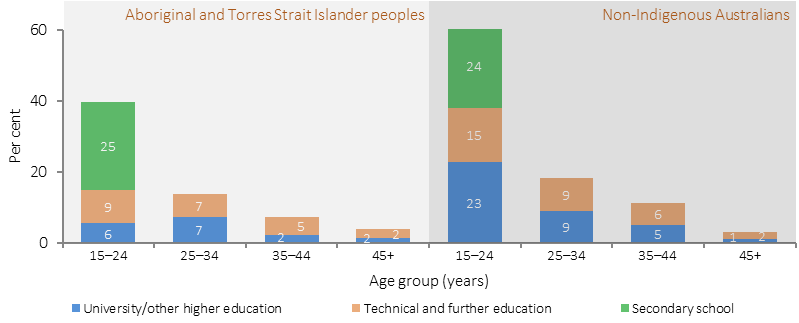
Source: ABS and AIHW analysis of 2014–15 NATSISS and 2014 GSS
Figure 2.06-2
Highest level of school completed, by Indigenous status, persons aged 18 years and over, 2002, 2008, 2012–13 and 2014-15
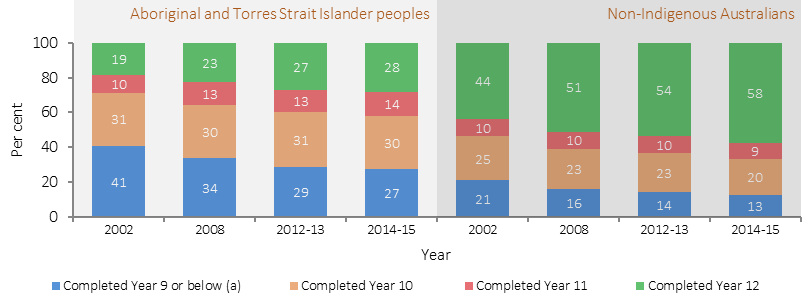
Note: Includes persons who never attended school.
Source: ABS and AIHW analysis of 2002, 2008 NATSISS and 2012–13 AATSIHS and 2014-15 NATSISS
Figure 2.06-3
Higher education award course completions, Indigenous students per 10,000 population 20-64 years, 1996 to 2015
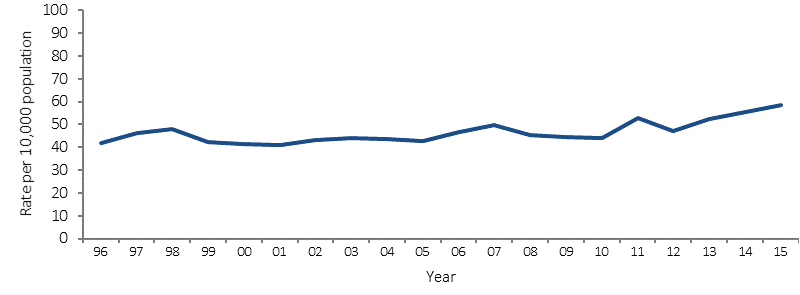
Source: AIHW analysis of Higher Education Statistics Collection
Figure 2.06-4
Total completions in the VET sector for persons aged 15 years and over, by Indigenous status, 1996 to 201 4
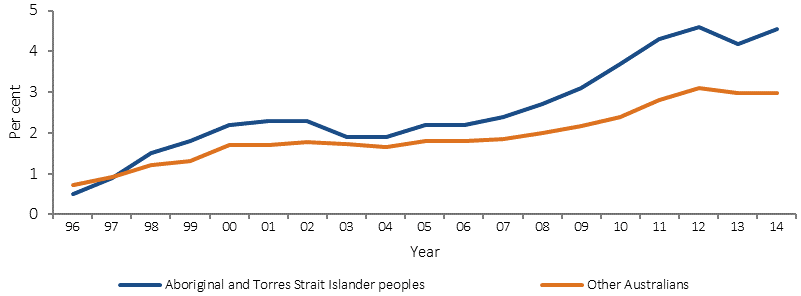
Source: AIHW analysis of NCVER, National VET Provider Collection, 2012
Figure 2.06-5
Non-school qualifications at Certificate III level or above, by Indigenous status and age group, persons aged 18 years and over, 2014-15
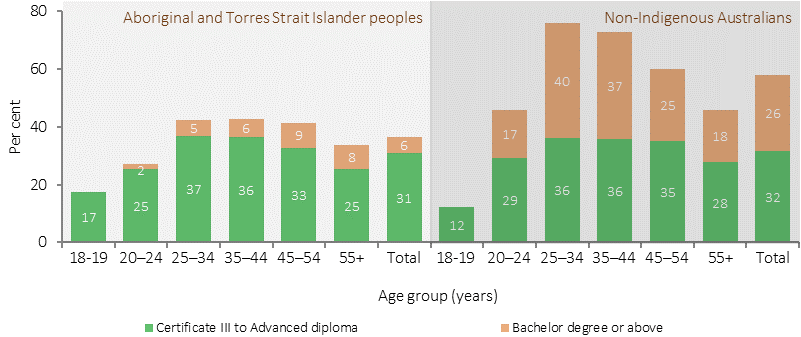
Source: ABS and AIHW analysis of 2014-15 NATSISS. Non-Indigenous estimates are from the GSS 2014
Implications
Concerted efforts to increase Year 12 attainment are positively contributing to increased numbers of Indigenous students enrolling in VET and higher education. COAG set a target to halve the gap in Year 12 attainment for Indigenous Australians aged 20–24 by 2020. The current rate, 62%, is up from 45% in 2008 and the target is on track.
However, significant numbers of Indigenous young people aged 17–24 years are currently not engaged in further education, training or employment. Ensuring that these young people are supported throughout their secondary schooling to make successful post-school transitions is critical to improve their employment prospects. The gap between Indigenous and non-Indigenous Australians in higher education is linked to the relative higher cost of education to those of lower socio-economic status (Hunter, BH, 2010); disability (Biddle, 2014b); the gap in academic achievement; and factors affecting educational choices (e.g. access to information, educational aspirations) (Parker, PD et al, 2013).
A range of initiatives being implemented across government are described in detail in the Policies and Strategies section.
In line with recommendations of the 2012 Review of Higher Education Access and Outcomes for Aboriginal and Torres Strait Islander People, all Australian universities have strategies in place for improving Indigenous Australians’ access to, and outcomes from, higher education.
The Indigenous Student Success (Higher Education) Programme (ISSP), announced in the 2016–17 Budget, will combine the Commonwealth Scholarships Program, Indigenous Support Program and tutorial assistance offered under the Indigenous Advancement Strategy into a single flexible program from 2017. Under the ISSP, universities will have greater flexibility to tailor services and support to meet the individual needs of each eligible student. The new arrangements will encourage universities to draw on the knowledge and expertise of Aboriginal and Torres Strait Islander people and support more Indigenous students to access and achieve university qualifications.
Financial assistance is available to Indigenous young people to study or do training via ABSTUDY. In 2015, over 4,000 Indigenous secondary students received ABSTUDY Away from Home entitlements.